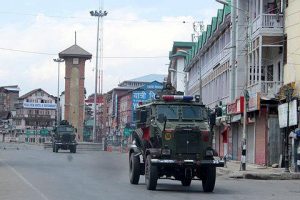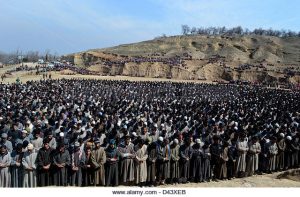Peace Watch » Editor's Take, Kashmir-Talk » The Kashmir “Civil Resistance” and Peoples’ Resolve and Beyond?
The Kashmir “Civil Resistance” and Peoples’ Resolve and Beyond?
Punchline
Intifadas and Peoples’ Amnesia
By
Z.G. Muhammad
In the eighty-five years long contemporary resistance movement of Jammu and Kashmir the 2016 ‘intifada’ so far has been the longest. In many ways, compared to earlier ‘intifadas’ it has been an unprecedented and extraordinary story of sufferings and resilience. In the history of Kashmir and the resistance movements across the globe as rightly said by Ellen Barry of the New York Times, “2016 will almost certainly be remembered as the year of dead eyes.” From age, six to eighties people suffered the ‘epidemic of dead eyes’ as the blinding of people with the pump-action “pellet guns” was described in the international media. For the first time in modern history children and school going girls were shot in the face with metal pellets or birdshot piercing their eyes. In fact across the world, there is no instance of firing of metal pellets on the protestors in their eyes and blinding them. The deadly pellets have hit over fifteen hundred directly in the eyes leaving them partially and fully blind for rest of the life.
The ‘intifada’ 2016, third in a series of ‘intifadas’ of the second decade of the twenty-first century and after a paradigm shift from the ‘armed resistance’ or “militancy” to peaceful protests is also unparalleled for the number of civilians- the non-combatants wounded and injured in police firings – bullets, lead pellets, tear smoke canisters and pepper gas shells. More than fifteen thousand people have been wounded and injured in four months- a colossal figure. More than eighty boys and girls killed- for their academic brilliance majority of them holding big promises for the society. 
From 1865, Kashmir has a long history of political incarceration, but detentions and arrests made during three months after 8 July 2014 at an average three thousand a month also have no parallel. Even by the reckoning of the Sadiq regime which is known for the highest number of arrests of political workers, students and citizen and blatant use draconian laws like the DIR and the PDA, the detentions during three months are far higher than at any point in time in the recent history. In a written reply the Ministry of Home Ministry (MHA) to a question couple of days back informed the Parliament that ‘7392 persons were arrested and bound down in Kashmir after the killing of a commander of Hizb-ul-Mujahideen on July 8. The FIRs registered against 4372 persons, and 472 persons detained under the Public Safety Act.’
Living true to their history of rising to the occasion at the spur of the moment; the people not only braved theses harshest tactics with a resolve but as a society collectively rose to face the record challenges thrown up by raw dealing of the protests by the authorities after the killing of Hizb commander Burhan Wani on Friday July 8, 2016 In the history of hospitals across the globe even during the war time the ophthalmologists might not have to deal with such huge number of children arriving in the hospitals with lead pellets having hit their eyes with matted up the lens, the irises, the retinas- and carry out operations in scores. It was the dedication of the doctors who tirelessly operated upon the pellet and bullet hit children and teenagers and saved lives and eyes of some. Nevertheless, many young girls and boys lost their vision forever, and some got disabled for life.
Notwithstanding, the curfew, and restrictions young and old came out to donate blood for the wounded, arrange medicine and essentials for those in need. Outside the hospitals tens of relief camps were established for providing food for the relatives of the wounded. Peopled vying each other and working with a zest for providing relief to the wounded spoke about the vitality of our bruised society. During all the macabre days the voluntarism, which has been from 13 July 1931 cardinal to the resistance movement of the state was at its peak not only in and outside the hospitals but almost in every village and mohalla. In every area overnight Bayt al-mals treasuries came up in every locality. These small institutional frameworks immensely helped in providing succor to thousands of daily wagers and minor traders. Importantly the shocking and sad four months like those of the early nineties largely senstise the society to the political blunders of the past that have brought the people of the state to this impasse. Nevertheless, the question that perhaps haunts all of us is, if as people we once again do not suffer from the ‘political memory lapse,’ as we suffered after 2008 and 2010 and allowed ourselves to get ensnared in some catchy slogans- believing that these will not affect the main narrative. Moreover wittingly and unwittingly worked for strengthening the “hegemonic discourses” ‘for gaining and maintaining power’- in our case for maintaining the status quo. These question should put the conscious and conscientious members of the society into an introspective mode and make them look for an answer. How to prevent general masses from getting entrapped in the “dominant discourse,” thus prolonging their miseries – is it leadership that has bigger role to play or the intelligentsia or the civil society – ‘class of collective intellectuals.’
The “Intifada 2016” like those of 2010 and 2008, by all definitions, have been “civil resistances”- a peaceful struggle. That to quote, Erica Chenoweth a scholar of Josef Korbel School of International Studies at the University of Denver ‘are more than twice effective in waging political struggles.’ Studies have shown that the ‘civil resistances’ has produced remarkable results and in the recent years succeeded in many parts of the world. It should engage all of us, to introspect why the “civil resistance” of 2008 and 2010, did not enable people to achieve their desired goal. Have we as people failed is the question that bothers many in our society?
The political struggles are a continuous process, and these do have their crests and troughs. The 2016 uprising is a continuation of 2008 and 2010. It also can pass into history like that of 2010 leaving space for another ‘intifada’ in some later year- if the status quo continues. Nevertheless, there is a basic flaw that our society suffers from, when ‘intifadas’ are at their high the overwhelming majority of people go the whole hog for it- even the traditional fence sitters are at the frontline. The voluntarism touches new heights, and in providing instant relief to the victims of the state repression, the social groups try to outsmart each other. Once the uprising calms down, our enthusiasm for social work evaporates as quickly as ether. The bereaved families that need continuous succor, the victims of violence- whether those disabled for life, blinded to live a miserable or those with impaired vision left to fend for themselves and forgotten.It happened in 2008, and 2010. The Society forgot the children blinded and disabled during 2010. Such behavior from the society with all its ostensible commitment to the cherished political goal was work to the disadvantage of the political and leave space for the ascendance of the hegemonic and dominant discourses.
2016, ‘intifada’ is leaving behind a harrowing legacy of blind children and disabled youth who have a long way to go. The society needs to come out of the syndrome of the “memory lapse” that it suffers from after every phase of the intifada and work for their institutionalized rehabilitation.
Some portions of article were published in Greater Kashmir on 28 November 2016.
Filed under: Editor's Take, Kashmir-Talk








a good observation though i have a submission. is it right to call it amnesia. why opening of business ventures, schools, day to day chorus in the so called period of normalcy is not owned, and advocated, as a “Passive phase”, against the present Active phase of Agitation. is this not what the state discourse is i.e., if business, offices, transport etc are on then it is we (the state) that is running its writ and if otherwise–bandhs, processions, killings–it is they (Agitators, Separatists). how can we call it amnesia when Kashmiris for last 86 years (particularly last 27yrs) have been steadfastly resisting the oppressors by letting everything dearer in the way. is it that the leadership and the intelligentsia have not been able to give the Struggle a vibrant, multifarious interpretation and response.?